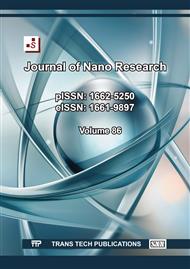[1]
V.J. Ramsden, Nanotechnology. An Introduction, Elsevier Inc., 2011.
Google Scholar
[2]
C.P. Poole, Jr. and F.J. Owens, Introduction to Nanotechnology, John Wiley & Sons, Inc., 2003.
Google Scholar
[3]
A. Nouailhat, An Introduction to Nanoscience and Nanotechnology, John Wiley & Sons, Inc. 2008.
Google Scholar
[4]
Kashin, A. S., Degtyareva, E. S., Eremin, D. B. and Ananikov, V. P. Exploring the performance of nanostructured reagents with organic-group-defined morphology in cross-coupling reaction. Nat. Commun. 9, 2936 (2018).
DOI: 10.1038/s41467-018-05350-x
Google Scholar
[5]
Gacutan, E. M. et al. Nanostructured carbon-supported Pd electrocatalysts for ethanol oxidation: synthesis and characterization. Adv. Nat. Sci. Nanosci. Nanotechnol. 3, 045016 (2012).
DOI: 10.1088/2043-6262/3/4/045016
Google Scholar
[6]
Kashin, A. S. & Ananikov, V. P. Monitoring chemical reactions in liquid media using electron microscopy. Nat. Rev. Chem. 3, 624–637 (2019).
DOI: 10.1038/s41570-019-0133-z
Google Scholar
[7]
Chen, J., Natte, K. & Wu, X.-F. Pd/C-catalyzed carbonylative C–H activation with DMF as the CO source. Tetrahedron Lett. 56, 6413–6416 (2015).
DOI: 10.1016/j.tetlet.2015.09.142
Google Scholar
[8]
Felpin, F. X. & Landais, Y. Practical Pd/C-Mediated Allylic Substitution in Water. J. Org. Chem. 70, 6441–6446 (2005).
DOI: 10.1021/jo050952t
Google Scholar
[9]
Trost, B. M., Kaneko, T., Andersen, N. G., Tappertzhofen, C. & Fahr, B. Total synthesis of aeruginosin 98B. J. Am. Chem. Soc. 134, 18944–18947 (2012).
DOI: 10.1021/ja309947n
Google Scholar
[10]
Mubeen, S., Zhang, T., Yoo, B., Deshusses, M. A. & Myung, N. V. Palladium Nanoparticles Decorated Single-Walled Carbon Nanotube Hydrogen Sensor. J. Phys. Chem. C 111, 6321–6327 (2007).
DOI: 10.1021/jp067716m
Google Scholar
[11]
Jia, X. et al. Synthesis of Palladium/Helical Carbon Nanofiber Hybrid Nanostructures and Their Application for Hydrogen Peroxide and Glucose Detection. ACS Appl. Mater. Interfaces 5, 12017–12022 (2013).
DOI: 10.1021/am4037383
Google Scholar
[12]
Liu, X. & Astruc, D. Development of the Applications of Palladium on Charcoal in Organic Synthesis. Advanced Synthesis and Catalysis, https://doi.org/10.1002/adsc.201800343 (2018).
Google Scholar
[13]
D.A. Boiko, E.O. Pentsak, V.A. Cherepanova and V.P. Ananikov, Electron microscopy dataset for the recognition of nanoscale ordering effects and location of nanoparticles, J. Scientific data, 7(1), (2020) 101-108.
DOI: 10.1038/s41597-020-0439-1
Google Scholar
[14]
G. Dahy, M.M. Soliman, H. Alshater, A. Slowik and A.E. Hassanien, Optimized deep networks for the classification of nanoparticles in scanning electron microscopy imaging, Computational Materials Science 223 (2023) 112135.
DOI: 10.1016/j.commatsci.2023.112135
Google Scholar
[15]
D.A. Boiko, E.O. Pentsak, V.A. Cherepanova, E.G. Gordeev and V.P. Ananikov, Deep neural network analysis of nanoparticle ordering to identify defects in layered carbon materials, Chemical Science 12.21 (2021): 7428-7441.
DOI: 10.1039/d0sc05696k
Google Scholar
[16]
Toscano, M.D. Torre, B.A. Juárez, and G.A.G. Mireles, Deep Learning for Nanoparticle Classification in SEM Micrographs: Systematic Mapping, In the 11th International Conference On Software Process Improvement (CIMPS), IEEE-publishing, 2022, pp.119-125.
DOI: 10.1109/cimps57786.2022.10035714
Google Scholar
[17]
Weilie, Z. and Zhong L. W. Scanning Microscopy for Nanotechnology Scanning Microscopy for Nanotechnology: Techniques and Applications. (Springer New York, 2007).
Google Scholar
[18]
Reimer, L. Scanning Electron Microscopy: Physics of Image Formation and Microanalysis 2nd edn (Springer-Verlag Berlin Heidelberg,1998).
Google Scholar
[19]
Singh, A. K. Experimental Methodologies for the Characterization of Nanoparticles. In Engineered Nanoparticles 125–170 (Elsevier, 2016).
Google Scholar
[20]
O. P. Vilela Neto, Intelligent Computational Nanotechnology: The Role of Computational Intelligence in the Development of Nanoscience and Nanotechnology, J. of Computational and Theoretical Nanoscience, 11, 928–944 (2014).
DOI: 10.1166/jctn.2014.3446
Google Scholar
[21]
W. Rawat and Z. Wang, Deep Convolutional Neural Networks for Image Classification: A Comprehensive Review, Neural computation 29.9 (2017): 2352-2449.
DOI: 10.1162/neco_a_00990
Google Scholar
[22]
Simonyan and A. Zisserman, Very deep convolutional networks for large-scale image recognition, arXiv preprint arXiv:1409.1556 (2014).
Google Scholar
[23]
Jia, X. et al. Synthesis of Palladium/Helical Carbon Nanofiber Hybrid Nanostructures and Their Application for Hydrogen Peroxide and Glucose Detection. ACS Appl. Mater. Interfaces 5, 12017–12022 (2013).
DOI: 10.1021/am4037383
Google Scholar
[24]
Liu, X. and Astruc, D. Development of the Applications of Palladium on Charcoal in Organic Synthesis. Advanced Synthesis and Catalysis, https://doi.org/10.1002/adsc.201800343 (2018).
Google Scholar
[25]
M.H. Modarres, R. Aversa, S. Cozzini, R. Ciancio, A. Leto, and G.P Brandino, Neural network for nanoscience scanning electron microscope image recognition, Scientific reports 7 (2017): 13282.
DOI: 10.1038/s41598-017-13565-z
Google Scholar
[26]
D. Kolenov, D. Davidse, J. Le Cam, and S. F. Pereira, Convolutional neural network applied for nanoparticle classification using coherent scatterometry data, Applied Optics 59, no. 27 (2020): 8426-8433.
DOI: 10.1364/ao.399894
Google Scholar
[27]
Dataset 127:
Google Scholar
[28]
Dataset 228:
Google Scholar
[29]
He, K., Zhang, X., Ren, S., and Sun, J. Deep residual learning for image recognition. In Proceedings of the IEEE conference on computer vision and pattern recognition (2016): 770-778.
DOI: 10.1109/cvpr.2016.90
Google Scholar


